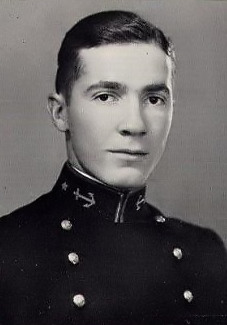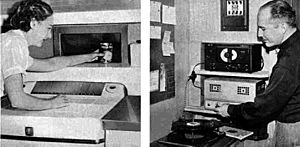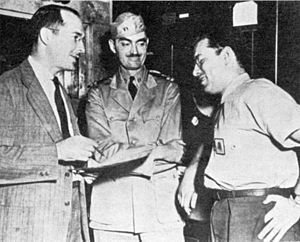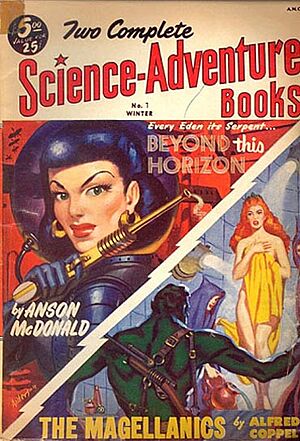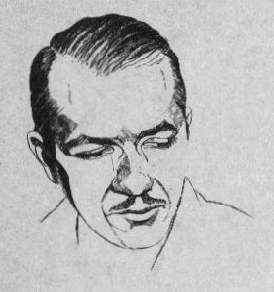Robert A. Heinlein facts for kids
Quick facts for kids
Robert A. Heinlein
|
|
|---|---|
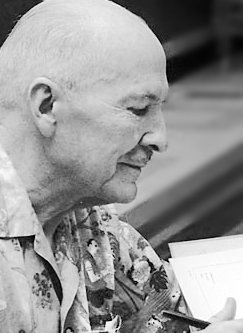
Heinlein in 1976
|
|
| Born | Robert Anson Heinlein July 7, 1907 Butler, Missouri, U.S. |
| Died | May 8, 1988 (aged 80) Carmel-by-the-Sea, California, U.S. |
| Pen name |
|
| Occupation |
|
| Alma mater | |
| Period | 1939–1988 |
| Genre | Science fiction, fantasy |
| Notable works |
|
| Spouse |
Elinor Curry
(m. 1929; div. 1930)Leslyn MacDonald
(m. 1932; div. 1947)Virginia Gerstenfeld
(m. 1948) |
|
|
|
| Signature | |
Robert Anson Heinlein (pronounced HYNE-lyne; July 7, 1907 – May 8, 1988) was a famous American writer. He is best known for his science fiction stories. He also worked as an aeronautical engineer (someone who designs aircraft and spacecraft). Plus, he was a naval officer in the U.S. Navy.
Many people called him the "dean of science fiction writers." He was one of the first authors to make sure the science in his stories was accurate. This made him a pioneer of hard science fiction. This type of sci-fi focuses on scientific details.
Heinlein's books often celebrated capable people. They also stressed the importance of critical thinking (thinking clearly and carefully). His stories often presented interesting situations. These made readers think about common social rules. His work still influences science fiction and culture today.
In the late 1940s, Heinlein was one of the first American science fiction writers. His stories were published in popular magazines. These included The Saturday Evening Post. For many years, his science fiction novels sold very well. He, along with Isaac Asimov and Arthur C. Clarke, are often called the "Big Three" of English science fiction writers.
Some of his most famous books include Stranger in a Strange Land, Starship Troopers, and The Moon Is a Harsh Mistress. Starship Troopers helped create ideas like space marines and giant robot suits called mecha. Some of his ideas were seen as thought-provoking. For example, the themes of citizenship in Starship Troopers made people think. He also created strong female characters who were very skilled.
Heinlein used his science fiction to explore interesting ideas. He wrote about society and government. He wondered how new science and technology might change politics. He also explored how people of different backgrounds get along. In his stories, Heinlein often wrote about the importance of individual liberty (freedom). He also wrote about relying on yourself. He thought about what people owe to their communities. He also explored how space travel might change human culture.
Heinlein was named the first Science Fiction Writers Grand Master in 1974. This is a top honor for sci-fi writers. Four of his novels won Hugo Awards. These awards are like the Oscars for science fiction. He also invented words that are now part of English. These include grok (to understand something deeply) and waldo (a type of robotic arm). He also helped make terms popular. These include "TANSTAAFL" (meaning nothing is truly free), "pay it forward", and "space marine". He even described an early idea for a waterbed in one of his novels.
Contents
Robert Heinlein's Life Story
Early Life and Education
Robert Heinlein was born on July 7, 1907, in Butler, Missouri. He was the third of seven children. His family had a tradition. Heinleins had fought in every American war since the War of Independence.
He grew up in Kansas City, Missouri. The values of this time and place influenced his writing. When he was a young child in 1910, Halley's Comet returned. This sparked his lifelong interest in astronomy.
Heinlein's family could not afford to send him to college. So, he wanted to go to a military academy. After high school, he worked hard to get into the United States Naval Academy at Annapolis. He was finally admitted in 1925.
Heinlein's time in the U.S. Navy greatly shaped his character and writing. He graduated from the Naval Academy in 1929. He had strong skills in engineering. He became an ensign in the Navy. In 1931, he was promoted to lieutenant junior grade. He served on the aircraft carrier USS Lexington. There, he worked with radio communications, which was new technology. He later served as a gunnery officer on the destroyer USS Roper. He reached the rank of lieutenant.
In 1934, Heinlein had to leave the Navy. He had pulmonary tuberculosis, a lung illness. During his time in the hospital, he thought of an idea for a waterbed.
Heinlein was married three times. His first marriage was short. In 1932, he married Leslyn MacDonald.
Later, Heinlein met Virginia "Ginny" Gerstenfeld. She was a chemical engineer. They became friends and then married in 1948. Robert and Ginny moved to Colorado Springs, Colorado. They designed their own house. It was even shown in Popular Mechanics magazine! They stayed married until Robert's death.
Ginny was a big inspiration for many of Heinlein's smart and independent female characters. She was a chemist and a rocket test engineer. She was also a talented athlete. Ginny was the first person to read Robert's stories. She gave him feedback. In 1953–1954, the Heinleins traveled around the world. This trip gave Robert ideas for his science fiction novels about long spaceship voyages. These included Podkayne of Mars and Friday.
Becoming a Successful Author
After leaving the Navy, Heinlein tried different jobs. For a while, money was tight. In the late 1930s, he started writing to earn money. His first published story, "Life-Line", appeared in August 1939. It was in Astounding Science Fiction magazine. People quickly saw his talent. He became a leading writer of "social" science fiction. This type of sci-fi explored ideas about society.
During World War II, Heinlein worked for the Navy as an engineer. He recruited other science fiction writers, Isaac Asimov and L. Sprague de Camp, to work there too.
After the war, Heinlein wanted to write for magazines that paid more. He published four important short stories in The Saturday Evening Post. The first was "The Green Hills of Earth" in 1947. This made him the first science fiction writer to become popular outside of sci-fi magazines. In 1950, the movie Destination Moon was released. Heinlein had written the story and helped with the script. It won an Academy Award for special effects.
From 1947 to 1959, Heinlein also wrote a series of science fiction books for teenagers. These books came out each fall, just in time for Christmas.
In 1959, his novel Starship Troopers was considered too controversial. His usual publisher decided not to publish it. Heinlein found another publisher. He then felt free to write more challenging books. He went on to write famous novels like Stranger in a Strange Land (1961) and The Moon Is a Harsh Mistress (1966).
Later Years and Passing
Starting in 1970, Heinlein had several serious health problems. When he felt well, he enjoyed his hobby of stonemasonry (building things with stone). In the mid-1970s, he and Ginny traveled across the U.S. They helped improve blood donation systems. Blood donations had saved his life.
In the late 1970s, his health declined again. He had a blocked artery in his neck. He had one of the earliest surgeries to fix this problem. This surgery gave him new energy. He wrote five more novels between 1980 and his death. Robert Heinlein died in his sleep on May 8, 1988. He passed away from emphysema (a lung disease) and heart problems.
Some of his writings were published after his death. These included letters, a book about politics, and a travel journal.
Robert Heinlein's Famous Written Works
Heinlein published 32 novels, 59 short stories, and 16 collections of stories during his life. His work has been turned into movies, TV shows, and even a board game.
Early Stories and Teen Novels (1939–1958)
Heinlein started his writing career with stories for Astounding Science Fiction magazine. Many people thought he was the best science fiction writer from his very first story.
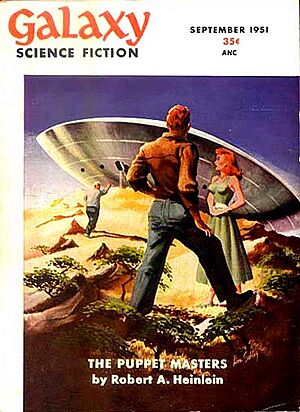
His first novel, For Us, the Living: A Comedy of Customs (written in 1939), was not published until 2003. It came out after his death. It explored many of his early ideas about society and relationships.
After this, Heinlein wrote many stories and novels. They were set in a "Future History." This was a timeline of future political, cultural, and technological changes. He also wrote a series of popular science fiction books for young adults. These books, often called "the Heinlein juveniles," mixed adventure with themes that teenagers could relate to. His main characters were usually smart young people. They were figuring out the adult world. Books like Have Space Suit—Will Travel and Farmer in the Sky are examples. He believed young readers were smart. He thought they could handle complex ideas.
His novel Red Planet included a story about a student-led revolution. His editor asked for changes. Some topics, like children using weapons, were considered too sensitive at the time.
Starship Troopers and New Ideas (1959–1960)
Heinlein finished his series of books for young adults with Starship Troopers (1959). This book tells the story of a young man growing up. He learns about duty, citizenship, and the military. In the society shown in the book, people earn the right to vote by serving the government. This often means serving in the military. This book caused some debate. However, it became very influential.
Exploring Big Ideas (1961–1973)
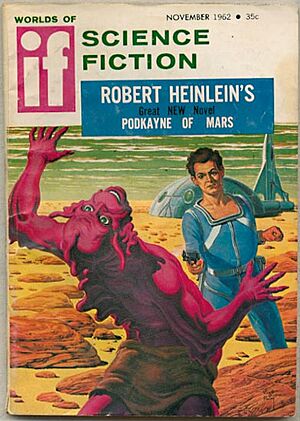
During this time, Heinlein wrote books that explored important themes. These included individualism (being true to yourself) and libertarianism (believing in maximum personal freedom). Three famous novels from this period are Stranger in a Strange Land, The Moon Is a Harsh Mistress, and Time Enough for Love. Many people who believe in libertarian ideas consider The Moon Is a Harsh Mistress to be a very important book.
Stranger in a Strange Land is about a human raised by Martians. He comes to Earth and has very different ideas about human customs. The Moon Is a Harsh Mistress tells the story of a lunar colony. It fights for independence from Earth.
Later Novels (1980–1987)
After a break due to health problems, Heinlein wrote five more novels. These books, like The Number of the Beast and To Sail Beyond the Sunset, often featured characters from his earlier stories. They also included long discussions about his ideas. These were about government, relationships, and religion. His 1982 novel Friday was an adventure story about a female secret agent.
Works Published After His Death
Several of Heinlein's works have been published since he died. These include For Us, the Living: A Comedy of Customs. There is also a collection of his letters called Grumbles from the Grave. A novel called Variable Star was written by author Spider Robinson. It was based on an outline Heinlein created.
Robert Heinlein's Ideas and Themes
Heinlein's books explored many ideas. These were about relationships, race, politics, and the military. His ideas were often seen as new and thought-provoking.
Politics and Freedom
Heinlein's political views changed during his life. When he was younger, he supported liberal ideas. He was involved with the Democratic Party. Later, he developed more conservative views. He supported politicians like Barry Goldwater. Throughout his life, Heinlein considered himself a libertarian. He strongly believed in individual freedom and limited government.
Thoughts on Race
Heinlein grew up when racial segregation was common in America. He used his fiction to argue for racial equality and tolerance. His early novels were unusual for their time. They often included main characters who were not white. For example, in his 1948 novel Space Cadet, he used aliens. This was a way to talk about minority groups. In The Star Beast, an important government official is a Black man from Africa. In Starship Troopers, the main character, Johnny Rico, is Filipino. Heinlein often challenged readers' ideas about race. He would reveal a character's ethnicity late in the story.
Individualism: Being Your Own Person
A strong belief in individualism is a key theme in Heinlein's work. He believed that individuals should think for themselves. They should also be self-reliant. His stories often show characters who are oppressed. But they also show characters who are oppressors. This makes readers think about both sides. Heinlein thought that education was very important. It helped individuals become competent adults. In Time Enough for Love, the character Lazarus Long lists many skills a person should have. He says, "Specialization is for insects."
The "Competent Person" Character
Heinlein often featured a type of character called the "competent man." This is a person who has many skills and knowledge. They can solve almost any problem. These characters are usually confident and experienced. Jubal Harshaw from Stranger in a Strange Land and Lazarus Long are good examples. This idea of a capable, multi-talented person was important in many of his stories.
"Pay It Forward"
Heinlein helped popularize the phrase "pay it forward". This idea means that if someone does something nice for you, you should do something nice for someone else. You do not pay them back directly. He mentioned this concept in his 1951 book Between Planets and other stories. This idea encourages a chain of kindness.
Robert Heinlein's Influence and Legacy
Impact on Science Fiction
Heinlein is considered one of the "Big Three" masters of science fiction. He is grouped with Isaac Asimov and Arthur C. Clarke. He helped science fiction become a more respected type of literature. He moved it beyond simple adventure stories. He was a leader in "social science fiction." This uses futuristic settings to explore social and political issues. He was also a key figure in "hard science fiction". This was because of his attention to scientific accuracy.

Writing Style and Advice
Heinlein was known for a writing technique called "indirect exposition" or "incluing." This means he would give small details. These let the reader figure out things about his fictional worlds. He did this without long explanations. This made his stories feel more real.
He also gave famous advice to aspiring writers. It is known as Heinlein's Rules:
- You must write.
- Finish what you start.
- You must not rewrite, unless an editor asks you to.
- You must offer your story for sale.
- You must keep it for sale until it has sold.
Words He Made Popular
Heinlein coined or popularized several words and phrases:
- Waldo: From his story "Waldo", this term now refers to robotic arms.
- Grok: A Martian word from Stranger in a Strange Land. It means to understand something so deeply that you become one with it.
- Space marine: Heinlein popularized this term for soldiers fighting in space.
- Speculative fiction: A term he used for serious, thoughtful science fiction.
Inspiring Culture and Technology
Heinlein's stories helped make space exploration seem like a real possibility. Many astronauts and people working in the U.S. space program grew up reading his books. A crater on Mars is named after him. When Apollo 11 landed on the Moon, Heinlein was a guest commentator on TV. He called it "the greatest event in human history." The word "grok" became popular in the 1960s. It is still used today.
The Heinlein Society
The Heinlein Society was started by Heinlein's wife, Virginia. It was created to "pay forward" his legacy. The society supports blood drives. It provides educational materials. It also encourages discussion of Heinlein's work and ideas. It gives out the Robert A. Heinlein Award for science fiction that inspires space exploration.
Honors and Awards
During his lifetime, Heinlein won four Hugo Awards for his novels: Double Star, Starship Troopers, Stranger in a Strange Land, and The Moon Is a Harsh Mistress. After his death, seven of his older works received "Retro Hugos". These were for stories published before the Hugos existed.
The Science Fiction Writers of America named Heinlein its first Grand Master in 1974. This was for his lifetime achievements. An asteroid (6312 Robheinlein) and a crater on Mars are named in his honor. In 2016, he was inducted into the Hall of Famous Missourians.
See also
 In Spanish: Robert A. Heinlein para niños
In Spanish: Robert A. Heinlein para niños


